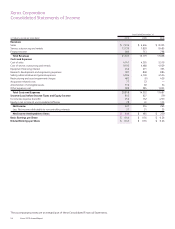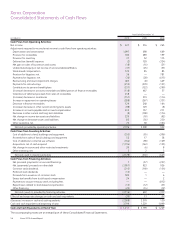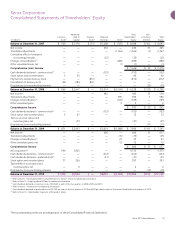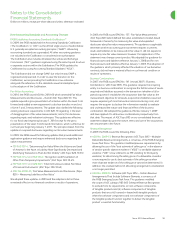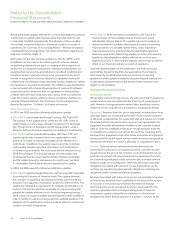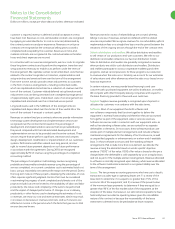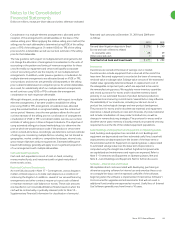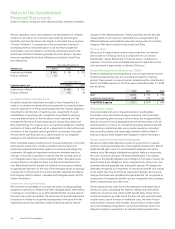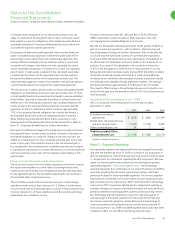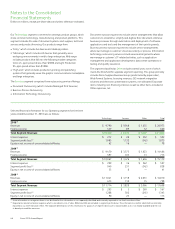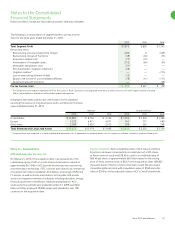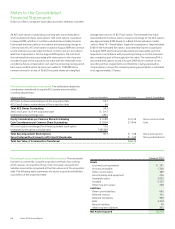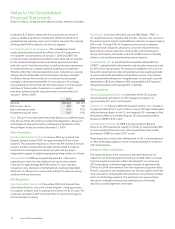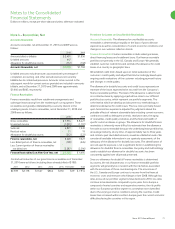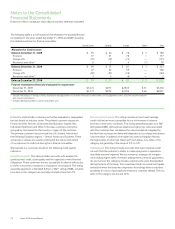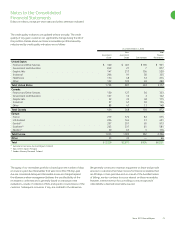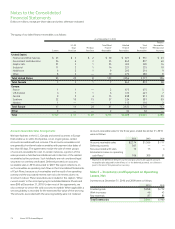Xerox 2010 Annual Report Download - page 66
Download and view the complete annual report
Please find page 66 of the 2010 Xerox annual report below. You can navigate through the pages in the report by either clicking on the pages listed below, or by using the keyword search tool below to find specific information within the annual report.
Notes to the Consolidated
Financial Statements
Dollars in millions, except per-share data and unless otherwise indicated.
64 Xerox 2010 Annual Report
charges) of the related operations. If these cash flows are less than the
carrying value of such asset, an impairment loss is recognized for the
difference between estimated fair value and carrying value. Our primary
measure of fair value is based on discounted cash flows.
Treasury Stock
We account for repurchased common stock under the cost method
and include such Treasury stock as a component of our Common
shareholders’ equity. Retirement of Treasury stock is recorded as a
reduction of Common stock and Additional paid-in capital at the time
such retirement is approved by our Board of Directors.
Research, Development and Engineering (“RD&E”)
Research, development and engineering costs are expensed as incurred.
Sustaining engineering costs are incurred with respect to ongoing
product improvements or environmental compliance after initial product
launch. Our RD&E expense for the three years ended December 31, 2010
was as follows:
2010 2009 2008
R&D $ 653 $ 713 $ 750
Sustaining engineering 128 127 134
Total RD&E Expense $ 781 $ 840 $ 884
Restructuring Charges
Costs associated with exit or disposal activities, including lease
termination costs and certain employee severance costs associated
with restructuring, plant closing or other activity, are recognized when
they are incurred. In those geographies where we have either a formal
severance plan or a history of consistently providing severance benefits
representing a substantive plan, we recognize severance costs when
they are both probable and reasonably estimable. Refer to Note 9 –
Restructuring and Asset Impairment Charges for further information.
Pension and Post-retirement Benefit Obligations
We sponsor defined benefit pension plans in various forms in several
countries covering employees who meet eligibility requirements. Retiree
health benefit plans cover U.S. and Canadian employees for retiree
medical costs. We employ a delayed recognition feature in measuring
the costs of pension and post-retirement benefit plans. This requires
changes in the benefit obligations and changes in the value of assets set
aside to meet those obligations to be recognized not as they occur, but
systematically and gradually over subsequent periods. All changes are
ultimately recognized as components of net periodic benefit cost, except
to the extent they may be offset by subsequent changes. At any point,
changes that have been identified and quantified but not recognized as
components of net periodic benefit cost, are recognized in Accumulated
Other Comprehensive Loss, Net of tax.
Several statistical and other factors that attempt to anticipate future
events are used in calculating the expense, liability and asset values
related to our pension and retiree health benefit plans. These factors
include assumptions we make about the discount rate, expected return
on plan assets, rate of increase in healthcare costs, the rate of future
compensation increases, and mortality. Actual returns on plan assets
are not immediately recognized in our income statement, due to the
delayed recognition requirement. In calculating the expected return
We also capitalize certain costs related to the development of software
solutions to be sold to our customers upon reaching technological
feasibility and amortize these costs based on estimated future revenues
(“Product Software”). In recognition of the uncertainties involved in
estimating revenue, that amortization is not less than straight-line
amortization over the software’s remaining estimated economic life.
Useful lives of Product Software generally vary from three to 10 years.
Amounts capitalized for Product Software are included in Cash Flows
from Operations.
Years Ended December 31,
Additions to: 2010 2009 2008
Internal use software $ 164 $ 98 $ 129
Product software 70 1 1
As of December 31,
Capitalized costs, net: 2010 2009
Internal use software $ 468 $ 354
Product software 145 10
Goodwill and Other Intangible Assets
Goodwill is tested for impairment annually or more frequently if an
event or circumstance indicates that an impairment loss may have been
incurred. Application of the goodwill impairment test requires judgment,
including the identification of reporting units, assignment of assets
and liabilities to reporting units, assignment of goodwill to reporting
units and determination of the fair value of each reporting unit. We
estimate the fair value of each reporting unit using a discounted cash
flow methodology. This requires us to use significant judgment including
estimation of future cash flows, which is dependent on internal forecasts,
estimation of the long-term rate of growth for our business, the useful
life over which cash flows will occur, determination of our weighted
average cost of capital and relevant market data.
Other intangible assets primarily consist of assets obtained in connection
with business acquisitions, including installed customer base and
distribution network relationships, patents on existing technology and
trademarks. We apply an impairment evaluation whenever events or
changes in business circumstances indicate that the carrying value of
our intangible assets may not be recoverable. Other intangible assets
are amortized on a straight-line basis over their estimated economic
lives. We believe that the straight-line method of amortization reflects
an appropriate allocation of the cost of the intangible assets to earnings
in proportion to the amount of economic benefits obtained annually by
the Company. Refer to Note 8 – Goodwill and Intangible Assets, Net for
further information.
Impairment of Long-Lived Assets
We review the recoverability of our long-lived assets, including buildings,
equipment, internal-use software and other intangible assets, when events
or changes in circumstances occur that indicate that the carrying value of
the asset may not be recoverable. The assessment of possible impairment
is based on our ability to recover the carrying value of the asset from the
expected future pre-tax cash flows (undiscounted and without interest


